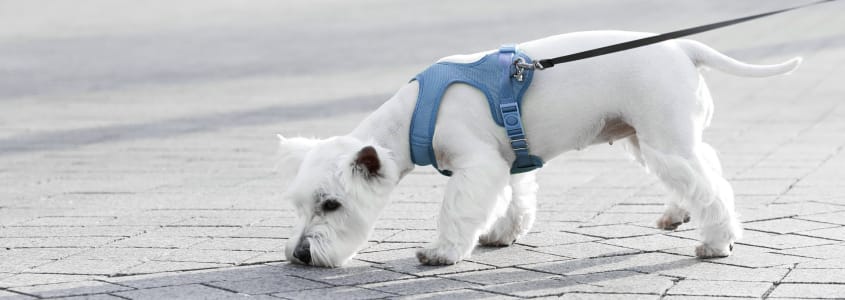
Osteoarthritis in dogs is a painful condition that gets worse over time. Today, our Milledgeville vets discuss osteoarthritis in dogs including its causes, signs, and treatment options.
Osteoarthritis in Dogs
Osteoarthritis is the most common form of arthritis seen in dogs. It is a degenerative joint disorder that leads to a permanent deterioration of the cartilage that provides cushioning for the joints. This painful condition is estimated to affect about a quarter of all dogs throughout their lifetime.
Signs of Osteoarthritis in Dogs
The painful joints caused by osteoarthritis can lead to several tell-tale signs that your dog may be suffering from osteoarthritis. The main symptoms of osteoarthritis in dogs include:
- Pain, stillness, and lameness
- Swollen joints
- Refusal to jump, use stairs, or run
- Reluctance to stand up
- Restlessness
- Lack of enthusiasm for walks or play
- Whining
- Irritability or aggression
- Licking joints
- Slow shuffling walk
Causes of Osteoarthritis in Dogs
While osteoarthritis can develop in any dog breed, it is most often diagnosed in larger breeds such as German Shepherds, Golden Retrievers, Labs, and Rottweilers.
The actual cause of osteoarthritis is largely unknown but this condition is often associated with underlying issues such as an injury due to trauma, hip dysplasia, elbow dysplasia, cruciate injury, or dislocations of the shoulder or knee.
Obesity is also associated with osteoarthritis. Excess weight can put unnecessary stress on the dog's joints leading to pain, and degenerative joint issues over time.
Helping Dogs With Osteoarthritis Live Comfortably
Osteoarthritis in dogs cannot be reversed or cured. Successful treatment of this condition reduces the pain caused by the affected joints, helps to slow the ongoing degeneration of the affected joints, and allows your dog to live more comfortably, and enjoy a good quality of life as they continue to age. Often several treatments will be used together to achieve pain relief and more comfortable mobility.
Diet
Managing your dog's weight will be a key element of their treatment for osteoarthritis. Increased weight puts increased stress on your dog's joints so keeping weight at a healthy level will help to minimize the pain caused by the condition.
Your vet may recommend putting your dog on a calorie-reduced diet if their exercise level has been reduced, or a diet supplemented with chondroitin sulfate, glucosamine sulfate, and omega-3 fatty acids as a way to combat symptoms.
Exercise
Although it may seem counterintuitive exercise is essential for dogs with osteoarthritis. It may be necessary to cut back on exercise when your dog is first diagnosed with osteoarthritis however staying mobile will help your dog to maintain fitness, achieve a healthy weight, relieve joint pain, and enjoy a good quality of life.
Exercise will need to be tailored to your dog's overall health and the severity of osteoarthritis. Your vet will be sure to recommend the best level of exercise to help relieve your dog's osteoarthritis symptoms.
Painkillers / Pain Meds
Painkillers such as anti-inflammatories are often prescribed as a long-term treatment for managing your dog’s joint pain and helping to reduce swelling.
Physical Rehabilitation
Physical rehabilitation is the name for physiotherapy for dogs and can include several treatments that are designed to help reduce pain while strengthening and improving muscle tone, maintaining range of motion, and working to improve overall endurance.
Physiotherapy for dogs with osteoarthritis may include one or more of the following treatments: therapeutic exercises, therapeutic ultrasound, cold laser therapy, regenerative therapy, neuromuscular electrical stimulation, underwater treadmill or pool therapy, and massage, combined with conventional treatments such as anti-inflammatory medications.
Speak to your vet to find a qualified Canine Physical Rehabilitation practitioner in your area.
Surgery
In some cases when joint damage is particularly extensive, your vet may recommend surgery to help alleviate symptoms and slow the progression of your dog's osteoarthritis. Surgery may be performed to remove bone fragments that aggravate the condition or replace the affected joints.
Prognosis for Dogs With Osteoarthritis
With effective long-term pain management and a little additional care, your dog may be able to enjoy a long and happy life even with osteoarthritis. Speak to your vet to learn more about managing your pup's joint pain, and how you can help your dog to enjoy a happy life for many years to come.
Note: The advice provided in this post is intended for informational purposes and does not constitute medical advice regarding pets. Please make an appointment with your vet for an accurate diagnosis of your pet's condition.

